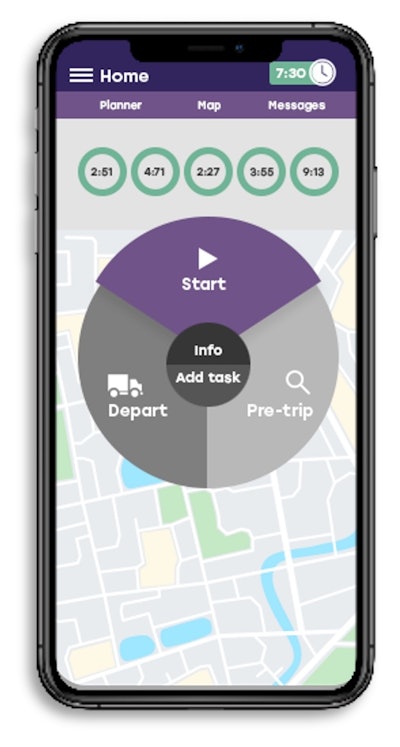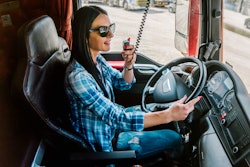The following is the third installment of a multi-part series that addresses the issues surrounding attracting younger drivers. The first part of the series, which focused on attracting students to the industry ahead of high school graduation, can be found here. The second part of the series included input from experts on how the insurance industry is approaching coverage of interstate drivers under age 21.
Just over a year and a half ago, drivers for building materials manufacturer Palmer-Donavin had a unit in their truck that monitored hours of service. Everything else – their manifest, routes, stops, etc. – was done on paper.
“They had a clipboard and they had to follow the sequence of delivery with a paperwork manifest. We didn't have a good GPS routing system integrated as well, so everything was a very manual process or they were winging it on their own,” said Tom Bartlett, vice president of operations at Palmer-Donavin.
Register today for "Finding and Keeping Drivers in a Demand-Driven Job Market" webinar
Executives from three fleets share the driver recruiting and retention strategies that have propelled their companies to become some of the industry’s best, and how they plan to stay there. This CCJ webinar is sponsored by Bestpass.
The company has since implemented Solera’s Omnitracs Drive platform that digitizes driver tasks, streamlining workflows via tablet. Bartlett said most everything now is done digitally.
As the next generation of truck drivers – those who have grown up with computers, internet and/or smartphones for their entire existence – enter the workforce, it is pertinent for the industry to create a digital experience that meets their technology standards to attract and retain them as the driver shortage worsens.
Both for-hire and private fleets, like building materials distributor Palmer-Donavin, are losing potential drivers to other professions as they enter the workforce two to three years prior the minimum age to obtain an Interstate CDL, so it’s more important than ever for companies to meet driver expectations.
[Related: Industry stakeholders work to attract new truck drivers before they enter the workforce]
“When you're dealing with older drivers, you have to foster effective change. You can sit down with an older driver used to handling paperwork and say, ‘Your life is going to get easier,’” said Darrin Demchuk, vice president of solutions at telematics and fleet management provider Platform Science. “The younger drivers who are like 'What's paper?', they come in with their expectations met.
“Younger people might be coming in with certain expectations of technology. They’re used to social media and smartphones. If you hand a 22-year-old driver fresh on the job a big stack of paperwork, they're going to probably be confused, like, ‘Why do I have all this paper? Why can't I just do this on my device or my phone or whatnot?’”
[Related: Tips for adopting technology among aging driver populations]
Platform Science works to build technology that is accessible to all generations, from fresh drivers in their 20s to the old-school truckers in their 70s. Bartlett said Omnitracs created like an app that is intuitive with minimal, if any, training needed, and he said it has helped his company with recruitment and retention.
“All of us download apps every day, and none of us are trained on these apps. (Omnitracs) is a very app-like product that you can give someone, and within minutes they're able to navigate and figure it out, as opposed to the old world of paperwork and driver logs and everything we had to deal with in the past that was very cumbersome and confusing,” Bartlett said. “Digitalization really simplifies it and makes it very user friendly. Not only does it help with our existing drivers, some of whom still have a flip phone – I think that that speaks to how easy it is to use – it also can be an advantage in recruiting because the younger generations are used to that type of interaction.”
Amos Rogan, Averitt (CCJ Top 250, No. 30) LTL operations leader, said recruitment, retention and driver training were part of Averitt’s primary reasons for adopting the Omnitracs Drive platform, too. He said it also allows the company to measure the productivity of its drivers more easily and with less administrative time, which has also led to better driver satisfaction.
The Omnitracs Drive platform digitizes routes from start to finish, supplying drivers with a sequential task format where they can’t go on to Step 2 without completing Step 1.
Rogan said this digital approach has increased efficiency, too, in addition to benefitting recruitment.
 Digitizing driver tasks with platforms like Omnitracs Drive can help fleets attract younger generations of drivers.Solera
Digitizing driver tasks with platforms like Omnitracs Drive can help fleets attract younger generations of drivers.Solera
Bartlett said it’s to the point now where if for some reason a driver’s tablet is out of service, they consider it an inconvenience to revert to the old-school paperwork they were once accustomed to.
“I think they see the importance and ease of use of what that does for them on a daily basis,” he said.
Moving to digital operations has helped Palmer-Donavin and Averitt streamline workflows, improve efficiency of training new drivers, improve communication with customers with a tracking notification system, simplify back-office operations and reduce the need for additional communications between drivers and dispatchers that waste time by inputting all the information a driver needs directly into the platform.
And Bartlett said he foresees digitalization opening many doors in the future, allowing for even better processes.
Rogan offered this advice to any company seeking to digitize driver tasks:
“Before reaching out to any provider or determining that you can develop this in house, know and understand the areas within your operation and back office that need improvement. Determine where you're good and where you want to be great and design a roadmap,” he said. “You are the expert of your operation, and once you put that together, the jump to more streamlined workflow processes is much easier to make.”












